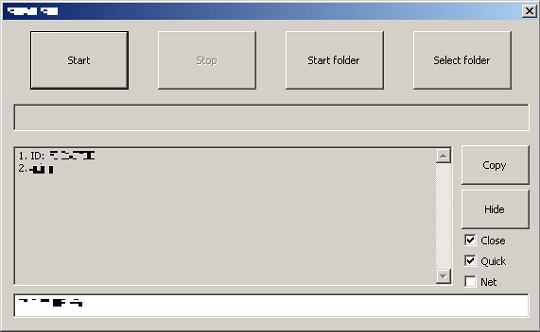Ransom.Win32.MAKOP.SM
Gen:Variant.Ransom.Makop.49 (BITDEFENDER), HEUR:Trojan-Ransom.Win32.Makop.vho (KASPERSKY)
Windows


Threat Type: Ransomware
Destructiveness: No
Encrypted: No
In the wild: Yes
OVERVIEW
This Ransomware arrives on a system as a file dropped by other malware or as a file downloaded unknowingly by users when visiting malicious sites.
It uses a user interface (UI).
It drops files as ransom note. It avoids encrypting files with the following file extensions.
TECHNICAL DETAILS
Arrival Details
This Ransomware arrives on a system as a file dropped by other malware or as a file downloaded unknowingly by users when visiting malicious sites.
Installation
This Ransomware adds the following folders:
- {Drive Letter}\YOUR_FILES_ARE_ENCRYPTED → if the selected folder to be encrypted is a drive
It adds the following processes:
- %System%\cmd.exe
- vssadmin delete shadows /all /quiet
- wbadmin delete catalog – quiet
- wmic shadowcopy delete
- {Malware File Path}\{Malware File Name} → if executed with administrator privileges.
(Note: %System% is the Windows system folder, where it usually is C:\Windows\System32 on all Windows operating system versions.)
It adds the following mutexes to ensure that only one of its copies runs at any one time:
- Local\ZonesLockedCacheCounterMutex
Process Termination
This Ransomware terminates the following processes if found running in the affected system's memory:
- msftesql.exe
- sqlagent.exe
- sqlbrowser.exe
- sqlservr.exe
- sqlwriter.exe
- oracle.exe
- ocssd.exe
- dbsnmp.exe
- synctime.exe
- agntsrvc.exe
- mydesktopqos.exe
- isqlplussvc.exe
- xfssvccon.exe
- mydesktopservice.exe
- ocautoupds.exe
- encsvc.exe
- firefoxconfig.exe
- tbirdconfig.exe
- ocomm.exe
- mysqld.exe
- mysqld-nt.exe
- mysqld-opt.exe
- dbeng50.exe
- sqbcoreservice.exe
- excel.exe
- infopath.exe
- msaccess.exe
- mspub.exe
- onenote.exe
- outlook.exe
- powerpnt.exe
- steam.exe
- thebat.exe
- thebat64.exe
- thunderbird.exe
- visio.exe
- winword.exe
- wordpad.exe
Download Routine
This Ransomware accesses the following websites to download files:
- {BLOCKED}ndowsupdate.com/msdownload/update/v3/static/trustedr/en/disallowedcertstl.cab?2bf7d05eae99c881
Other Details
This Ransomware connects to the following URL(s) to get the affected system's IP address:
- {BLOCKED}er.org/1xdAe7
It uses the following user interface:
It does the following:
- It scans specific database-related file extensions:
- 4dd
- 4dl
- abs
- abx
- accdb
- accdc
- accde
- adb
- adf
- ckp
- db
- db-journal
- db-shm
- db-wal
- db2
- db3
- dbc
- dbf
- dbs
- dbt
- dbv
- dcb
- doc
- docx
- dp1
- eco
- edb
- epim
- fcd
- gdb
- mdb
- mdf
- ldf
- myd
- ndf
- nwdb
- nyf
- sqlitedb
- sqlite3
- sqlite
- xls
- xlsx
- xlsm
Ransomware Routine
This Ransomware avoids encrypting files with the following strings in their file name:
- boot.ini
- bootfont.bin
- ntldr
- ntdetect.com
- io.sys
- readme-warning.txt
- desktop.ini
It avoids encrypting files found in the following folders:
- Users\Public
- %ProgramData%\microsoft\windows\caches
- %System Root%\Users\All Users\Microsoft\Windows\Caches
(Note: %ProgramData% is a version of the Program Files folder where any user on a multi-user computer can make changes to programs. This contains application data for all users. This is usually C:\ProgramData on Windows Vista, 7, 8, 8.1, 2008(64-bit), 2012(64-bit) and 10(64-bit), or C:\Documents and Settings\All Users on Windows Server 2003(32-bit), 2000(32-bit) and XP.. %System Root% is the Windows root folder, where it usually is C:\ on all Windows operating system versions.)
It appends the following extension to the file name of the encrypted files:
- {Original File Name}.{Original File Extension}.[{Victim ID}].[{BLOCKED}pher@cock.li ].makop
It drops the following file(s) as ransom note:
- {Drive Letter}\YOUR_FILES_ARE_ENCRYPTED\readme-warning.txt → if the selected folder is a drive
- {Encrypted Directory}\readme-warning.txt

It avoids encrypting files with the following file extensions:
- .makop
- .CARLOS
- .Shootlock
- .Shootlock2
- .1recoesufV8Sv6g
- .1recocr8M4YJskJ7
- .btc
- .KJHslgjkjdfg
- .exe
- .dll
SOLUTION
Step 1
Trend Micro Predictive Machine Learning detects and blocks malware at the first sign of its existence, before it executes on your system. When enabled, your Trend Micro product detects this malware under the following machine learning name:
- Troj.Win32.TRX.XXPE50FFF069
Step 2
Before doing any scans, Windows 7, Windows 8, Windows 8.1, and Windows 10 users must disable System Restore to allow full scanning of their computers.
Step 3
Note that not all files, folders, and registry keys and entries are installed on your computer during this malware's/spyware's/grayware's execution. This may be due to incomplete installation or other operating system conditions. If you do not find the same files/folders/registry information, please proceed to the next step.
Step 4
Search and delete these files
- {Encrypted Directory}\readme-warning.txt
- {Drive Letter}\YOUR_FILES_ARE_ENCRYPTED\readme-warning.txt
Step 5
Search and delete this folder
- {Drive Letter}\YOUR_FILES_ARE_ENCRYPTED
Step 6
Scan your computer with your Trend Micro product to delete files detected as Ransom.Win32.MAKOP.SM. If the detected files have already been cleaned, deleted, or quarantined by your Trend Micro product, no further step is required. You may opt to simply delete the quarantined files. Please check the following Trend Micro Support pages for more information:
Step 7
Restore encrypted files from backup.
Did this description help? Tell us how we did.


